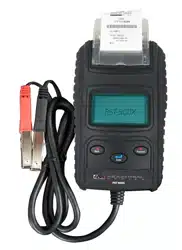Loading ...
Loading ...
Loading ...

• 5 •
5. The screen will show SET CAPACITY
and a number with the rating you
previously chose. To change the
capacity to different number, press the
FORWARD or BACK button. Once
the correct battery capacity has been
selected, press ENTER.
TEST RANGES:
SAE: 40-2000 CCA
DIN: 25-1300 CCA
IEC: 30-1500 CCA
EN: 40-2100 CCA
JIS: By battery type number
6. The screen will show TESTING. After
few seconds, the screen will show
the test results. After the results are
displayed, press ENTER.
NOTE: If the tester determines that the
battery voltage is low (based on the type,
rating and capacity that was previously
input), it will ask IS BATTERY CHARGED?
(This means: Has the battery been charged
without any drain placed on it within the last
24 hours?) Press the FORWARD or BACK
button to choose between YES and NO.
Once the correct option has been selected,
press ENTER.
7. When the test is complete, the display
shows the volts and CCA or percent
of charge. Press the FORWARD or
BACK button to select: SOH (STATE
OF HEALTH) or SOC (STATE OF
CHARGE). One of ve results will be
displayed:
GOOD AND PASS – The battery is good.
RECHARGE AND RETEST – Recharge
and retest the battery.
BAD AND REPLACE – Replace the battery.
BAD CELL AND REPLACE – Replace
the battery.
LOAD ERROR – The battery is bigger
than 2000 CCA.
8. The screen will show CODE and a
computer generated code number. After
the code is displayed, press ENTER.
9. The screen will show PRINT RESULTS
and YES or NO. Press the FORWARD
or BACK button to choose. Press
ENTER to print the results. NOTE: If
you select YES to print, after you’ve
printed the number of copies you need,
you must select NO to return to the
BATTERY TEST screen.
10. Remove the clamps from the battery
posts to end the test.
CHARGING SYSTEM TEST
1. Clamp the positive (red) clamp to
the positive (POS, P, +) battery post.
Clamp the negative (black) clamp to
the negative (NEG, N, -) battery post.
2. The screen will come on and display
BATTERY TEST with the voltage of the
battery. Press the FORWARD button
to get to the SYSTEM TEST, and then
press ENTER.
3. Turn off all accessories and loads
before starting the engine.
4. When the engine started, one of the
three following results will be displayed,
along with the actual reading measured:
CRANKING VOLTS NORMAL – The
system is showing normal draw.
CRANKING VOLTS LOW – The cranking
voltage is below normal limits; troubleshoot
the starter with the manufacturer’s
recommended procedure.
CRANKING VOLTS NOT DETECTED –
The cranking voltage is not detected.
5. If cranking voltage is normal, press
ENTER to begin the charging system test.
6. The display will show PRESS ENTER
FOR CHARGING TEST. Press ENTER
to continue.
7. The display will show MAKE SURE
ALL LOADS ARE OFF. Conrm that
all accessories are off. Press ENTER
to continue.
8. One of the three following results will
be displayed, along with the actual
reading measured:
LOW CHARGING VOLTS WHEN AT
IDLE – The alternator is not providing
sufcient current to the battery.
CHARGING SYSTEM NORMAL WHEN
AT IDLE – No problem is detected.
The system is showing normal output
from the alternator.
HIGH CHARGING VOLTS WHEN AT
IDLE – The voltage output from the
alternator to the battery exceeds the
normal limits of a functioning regulator.
9. After you are through with testing the
charging system at idle, press ENTER
to test the charging system with
accessory loads. The display screen will
show TURN ON LOADS AND PRESS
ENTER. Turn on the blower to high
(heat), high beam headlights and rear
defogger. Do not use cyclical loads,
such as air conditioning or windshield
wipers. Press ENTER to continue.
Loading ...
Loading ...
Loading ...
